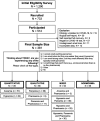This is a preprint.
Proof-of-concept: SCENTinel 1.1 rapidly discriminates COVID-19 related olfactory disorders
- PMID: 35350197
- PMCID: PMC8963695
- DOI: 10.1101/2022.03.23.22272807
Proof-of-concept: SCENTinel 1.1 rapidly discriminates COVID-19 related olfactory disorders
Update in
-
Proof-of-concept: SCENTinel 1.1 rapidly discriminates COVID-19-related olfactory disorders.Chem Senses. 2023 Jan 1;48:bjad002. doi: 10.1093/chemse/bjad002. Chem Senses. 2023. PMID: 36796784 Free PMC article.
Abstract
It is estimated that 20-67% of those with COVID-19 develop olfactory disorders, depending on the SARS-CoV-2 variant. However, there is an absence of quick, population-wide olfactory tests to screen for olfactory disorders. The purpose of this study was to provide a proof-of-concept that SCENTinel 1.1, a rapid, inexpensive, population-wide olfactory test, can discriminate between anosmia (total smell loss), hyposmia (reduced sense of smell), parosmia (distorted odor perception), and phantosmia (odor sensation without a source). Participants were mailed a SCENTinel 1.1 test, which measures odor detection, intensity, identification, and pleasantness, using one of four possible odors. Those who completed the test (N = 381) were divided into groups based on their self-reported olfactory function: quantitative olfactory disorder (anosmia or hyposmia, N = 135), qualitative olfactory disorder (parosmia and/or phantosmia; N = 86), and normosmia (normal sense of smell; N = 66). SCENTinel 1.1 accurately discriminates quantitative olfactory disorders, qualitative olfactory disorders, and normosmia groups. When olfactory disorders were assessed individually, SCENTinel 1.1 discriminates between hyposmia, parosmia and anosmia. Participants with parosmia rated common odors less pleasant than those without parosmia. We provide proof-of-concept that SCENTinel 1.1, a rapid smell test, can discriminate quantitative and qualitative olfactory disorders, and is the only direct test to rapidly discriminate parosmia.
Keywords: Anosmia; hyposmia; parosmia; phantosmia; prediction; smell test.
Conflict of interest statement
Competing interests On behalf of the authors of this manuscript, the Monell Chemical Senses Center and Temple University have been awarded patent protection (US patent no 11,337,640) and this patent has been licensed to Ahersla Health, Inc. The authors may benefit financially through their institution’s patent policy.
Figures




Similar articles
-
Proof-of-concept: SCENTinel 1.1 rapidly discriminates COVID-19-related olfactory disorders.Chem Senses. 2023 Jan 1;48:bjad002. doi: 10.1093/chemse/bjad002. Chem Senses. 2023. PMID: 36796784 Free PMC article.
-
SCENTinel 1.0: Development of a Rapid Test to Screen for Smell Loss.Chem Senses. 2021 Jan 1;46:bjab012. doi: 10.1093/chemse/bjab012. Chem Senses. 2021. PMID: 33773496 Free PMC article.
-
SCENTinel 1.0 : development of a rapid test to screen for smell loss.medRxiv [Preprint]. 2020 Dec 11:2020.12.10.20244301. doi: 10.1101/2020.12.10.20244301. medRxiv. 2020. Update in: Chem Senses. 2021 Jan 1;46:bjab012. doi: 10.1093/chemse/bjab012. PMID: 33330892 Free PMC article. Updated. Preprint.
-
Olfactory Nomenclature: An Orchestrated Effort to Clarify Terms and Definitions of Dysosmia, Anosmia, Hyposmia, Normosmia, Hyperosmia, Olfactory Intolerance, Parosmia, and Phantosmia/Olfactory Hallucination.ORL J Otorhinolaryngol Relat Spec. 2023;85(6):312-320. doi: 10.1159/000530211. Epub 2023 Apr 14. ORL J Otorhinolaryngol Relat Spec. 2023. PMID: 37062268 Free PMC article. Review.
-
Parosmia and Phantosmia: Managing Quality Disorders.Curr Otorhinolaryngol Rep. 2023;11(1):19-26. doi: 10.1007/s40136-023-00441-w. Epub 2023 Jan 27. Curr Otorhinolaryngol Rep. 2023. PMID: 36721659 Free PMC article. Review.
References
-
- Bonfils P, Avan P, Faulcon P, Malinvaud D. Distorted odorant perception: analysis of a series of 56 patients with parosmia. Arch Otolaryngol Head Neck Surg. 2005. Feb;131(2):107–12. - PubMed
-
- Hummel T, Whitcroft KL, Andrews P, Altundag A, Cinghi C, Costanzo RM, et al. Position paper on olfactory dysfunction. Rhinology. 2016. Jan 31;56(1):1–30. - PubMed
-
- Croy I, Nordin S, Hummel T. Olfactory disorders and quality of life--an updated review. Chem Senses. 2014. Mar;39(3):185–94. - PubMed
-
- Gerkin RC, Ohla K, Veldhuizen MG, Joseph PV, Kelly CE, Bakke AJ, et al. Recent smell loss is the best predictor of COVID-19 among individuals with recent respiratory symptoms. Chem Senses [Internet]. 2020. Dec 25 [cited 2021 Feb 11];(bjaa081). Available from: 10.1093/chemse/bjaa081 - DOI - PMC - PubMed
Publication types
Grants and funding
LinkOut - more resources
Full Text Sources
Miscellaneous
